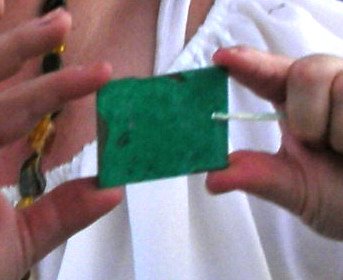 I have sewn up everything but the hems on the three dresses. Here are some pictures of them outside under the walnut tree. I really like the flow of the walnut dyed dress on the far right. On the far left is the plain, natural silk. The pattern is my own. I have included a rough bitmap but I don't think it is a very good drawing.
I have sewn up everything but the hems on the three dresses. Here are some pictures of them outside under the walnut tree. I really like the flow of the walnut dyed dress on the far right. On the far left is the plain, natural silk. The pattern is my own. I have included a rough bitmap but I don't think it is a very good drawing. It is a pretty basic tunic with gores.
It is a pretty basic tunic with gores.I think many folks in SCA use a similar tunic design for the under dress. What is extant is mostly just little fragments of weave or trim. Trim helps keep fabric. People are apt to cut off the end of a sleeve and stick it in a trunk for later use. It has given me a few ideas on what is extant and what is not. We keep preaching this 'there is no extant 12th century garb' but there are a few rare pieces and loads of fragments. You can tell a lot from a fragment. One thing I have learned from patterning is that no two people do it exactly the same way. The big thing is achieving the look you want. If you have that planned out in advance, you won't have serious issues.
One thing we have not found with extant pieces is the curved armpit as in my pattern. Extant pieces tend to have diagonal gores or triangles in the armpit. That could easily be done on this cutting diagram by taking the triangular gore out of the corner between the sleeve extensions and the armpit. Squaring off the arm of the dress would be valuable too. Why didn't I do this? I like to take advantage of the bias of the fabric. That kind of stretchiness allows me to wear the same dress, fighting or not. My latissimus dorsi muscle tends to change shape when I am fighting. This has caused me problems in the past. I will make garb and it won't fit because of the muscle. That happened to me during my "Year of the Norse" clothing scare. 8 dresses, two of which still fit.
The sleeves are plenty long and it seems I can get on with lining the cloak and making the over dress. I have been very intersted in doing sleeve treatments from Chartres on my aqua silk, but I am not sure which ones to do. I had better get on it soon.

No comments:
Post a Comment